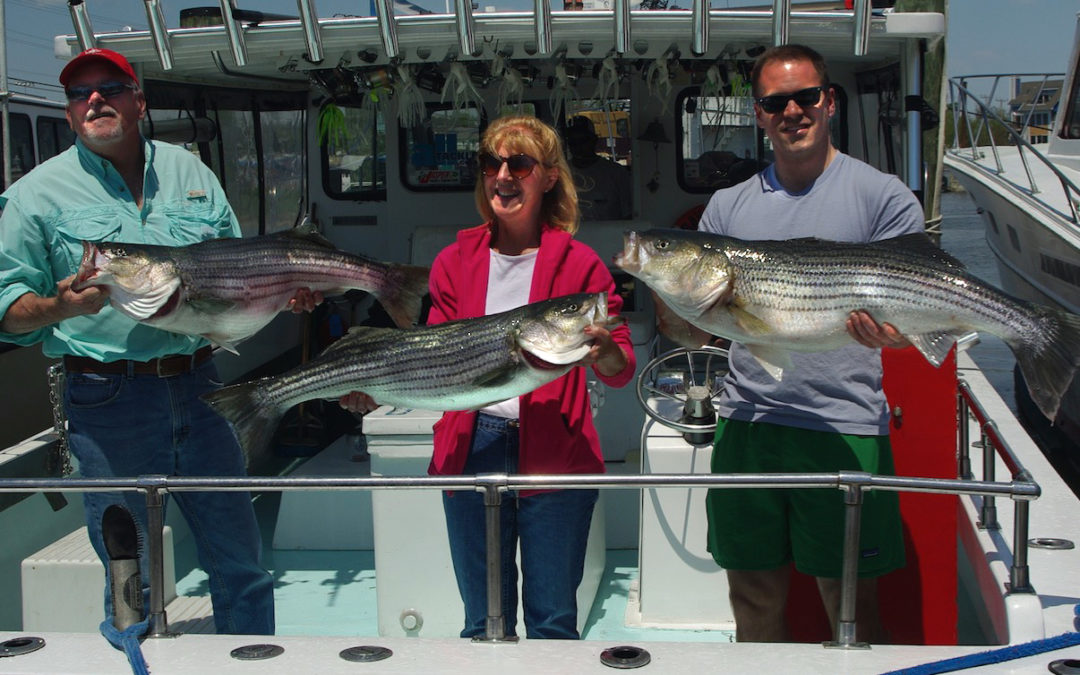“Yesterday, there were hundreds of boats out here,” he said as we took the short ride out to start the morning’s fishing. “Now there’s only a handful. That’s nice.”
We not only had Chesapeake Bay to ourselves, but also calm water, bright blue sky and temperature in the low 60s. The boat, the 42-foot Chesapeake Dead Rise, chugged steadily along with Randy at the helm while mate Jason Norton hustled to prepare two outriggers and 20 rods. Each line pulled a Bloody Point Parachute lure—a 3-ounce lead head with a Mylar skirt and a 9-inch soft shad body.
“The lures imitate menhaden or bunker,” Captain Randy explained. “These fish have been up the rivers to spawn and are coming back cold and hungry—that’s why they’re fairly shallow first thing in the morning. The water’s a little warmer at the surface.”
Rockfish spend much of their lives in the Atlantic and enter and exit the Chesapeake at its mouth on the southern end. We hoped to hook big female fish longer than 30 inches. The length is important for a number of reasons, not the least of which is, should you bring to dock a fish that doesn’t fall into the slot limit, you will be keelhauled by Maryland DNR fisheries agents.
We fished during the spring trophy season, which runs April 18 to May 15. Trophy means each angler is allowed to bring home a single fish per day, and the keeper must be between 28 and 36 inches long, or longer than 40. Not 39.99 inches either. We caught and released one of those—that tail will only stretch so far.
Once we arrived at Randy’s favorite spot, a channel in 35 feet of water, the Lowrance began showing plenty of fish, but they were a little sheepish at first. Thirty minutes later, however, we got a hit. Jay, my stepson, took the rod, slid the handle into the fighting belt, and went to battle. He’s young and healthy, but the powerful fish gave him a good workout.
Jay continued to crank, and after five minutes, the clear water revealed the white shad imitation and the striped monster attached to it. Close by, another equally large rockfish attempted to snatch the lure from the hooked fish’s jaw.
Jason stood by with his oversized net, and hauled Jay’s striper over the transom. We stared down with awe at the size of the specimen. Even Jason, who gets to see these fish most every spring day, was excited. After photos, he measured the fish: 39½ inches. Close but no cigar. We quickly returned the big girl to the drink.
Over the next three hours Kathy, Jay, and I caught six rockfish, ranging in sizes from 35½ to 40¼ inches. Three catch-and-releases, three keepers. A good morning by most anybody’s standards.
As we putted along at two to three knots waiting for another bite, I asked the captain to describe a typical year of fishing on these waters.
“Our season closes from the middle of December to the middle of April. Then we go after migrating fish like these. As it gets warmer, we’ll start live-lining with spots for bait. We’ll catch rockfish that way until we can’t catch bait any longer, which is usually some time in October.”
“In the last week of May and on into June, once we catch our day’s limit of rockfish, we’ll drift soft crabs for black drum. Then toward the end of June, we’ll cut spots into chunks and chum for bluefish.”
Striped bass, however, aren’t the only fish in the bay. As the water warms up Randy says they start catching more species of fish, such as red drum and Spanish mackerel. “In the summer months, you can almost pick your species,” he says.
The rockfish, though, are the biggest attraction, and those stripers support a healthy tourism industry. Chesapeake Beach is a prime example. We spent Sunday night at the Chesapeake Beach Resort, which for decades has been a top choice of visiting fishermen. And why not? It’s located just a few steps from the Rod ‘N’ Reel Marina where many of the best charter boats, including Captain Randy’s Bay Hunter, are docked. There’s also the Rod ‘N’ Reel Restaurant, a video game casino, plus a salon and spa.
For general questions about places to go, things to see and fish to catch in Maryland, visit www.visitmaryland.org.





